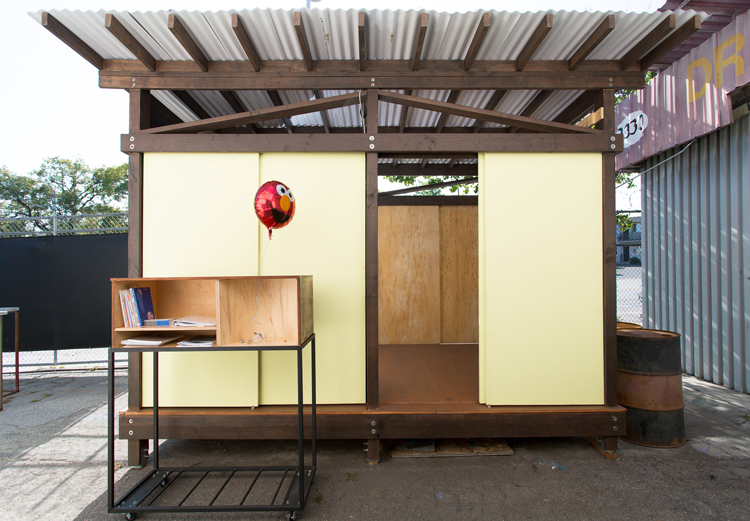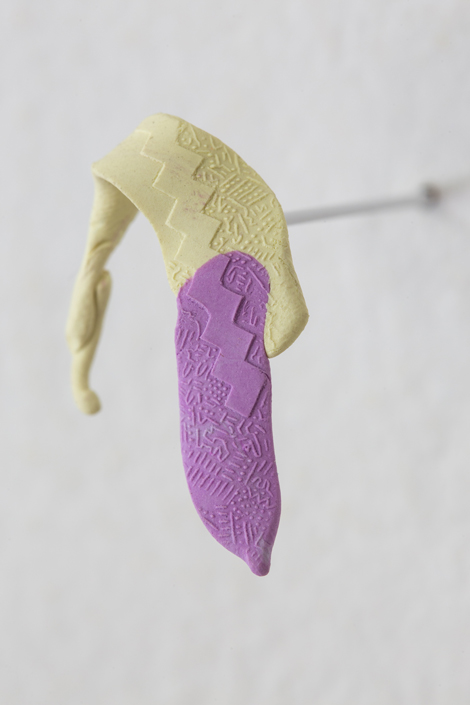Alongside Los Angeles’ mainstream exhibition spaces, an eddy of alternative art venues swirl for a time, submerge and disappear, enjoying varying degrees of notice. A few of these combine entrepreneurial efforts along with more altruistic programming, reflecting the difficult financial realities of opening a space. Some venues rent out their facility for private parties, charity galas or other events. Many small spaces exist as the alter ego of an artist’s studio or even in the intimate confines of an artist’s apartment. Artists who launch these types of efforts often desire to create experimental venues untouched by the demands of commerce. And so the living room of a cramped apartment is used to show the work of friends. The impulse to be free of the looming presence of a dealer or the dictates of the gallery system goes hand-in-glove with the need to engage in discourse with peers.
I stumbled onto Laurel Doody through a friend who suggested we drop in one Saturday afternoon on our way to another venue. We pulled up to a 1950s-era apartment building along the Miracle Mile. Up a flight of stairs, around two corners, in front of a slightly ajar screen door, several pairs of neatly arranged shoes adorned a thick welcome mat. The sounds of a lively group of people echoed from inside the apartment. We were warmly greeted , and after brief introductions, offered cake and tea. Two people sat in a pair of restored Sergio Rodrigues chairs, chatting, admiring the three works on the opposite wall. Two more stood on the sisal flooring in their stocking feet engaged in animated discussion.
Laurel Doody is the brainchild of Fiona Connor. The idea came to Connor after she began using her apartment/studio as an exhibition space. “Before this project,” she said, “I presented quite a lot of work in this space when it was just my apartment. I did this installation where I took real estate signs from the area. I moved all the furniture out and presented them here [in the living room]. And then there was this ceiling mural. That was definitely more of a reckless thing.” Finding that people really responded to looking at work in an apartment, she began to think about putting on curated shows.
Although Laurel Doody grew out of her previous practice, Connor delineates, “I feel like Laurel Doody, she’s got a different personality.” And, indeed, Laurel Doody retains the associations of a domestic space and can feel wonderfully intimate—informal conversations over food, viewing art from comfortable, low-slung leather chairs—yet it is adorned with white cube accoutrements. Connor named the gallery after a close family friend who she described as a mentor, someone who is a lot of fun and a little bit naughty. She said, “I really adore her [the real Doody], and I wanted to name the gallery after something that would make me really happy.” Connor worked with architect Erin Besler to produce drawings of the gallery and distributed the floor plan to the artists who will be showing in the space. “That experience of getting a floor plan from a gallery, it suggests so much,” said Connor. “It says how professionalized you are, or what you consider important or the way you want to present your space. I think as a document, it becomes a really important part of the project.”
Connor designed Laurel Doody as a 12-month project with five exhibitions. The duration of the project is in part because of its inherent challenges. Connor has been involved with artist-run spaces before and those, she says were artist-funded. “We used to pay for the rent out of our pockets.” She was fortunate enough to receive enough seed money from a small group of collectors to get the project rolling. But the biggest contributions are not monetary and have come from the artists and other people she is working with.
“It was awesome because I had a very strong hunch about the whole thing,” Connor said. “It doesn’t really fit into a capitalist structure, but it’s still worth doing. It’s still incredibly nourishing and fun.”
On an entirely different side of town, the Los Angeles Museum of Art (LAMOA), run by Alice Könitz, sits on a fenced-off concrete slab in front of a light industrial building full of artist studios. The ambient sounds of traffic on Eagle Rock Boulevard are backdrop to the small, 9 x 13-foot structure housing the museum. Könitz showed me the project space and bookstore that sit outside the modular museum structure, which is influenced by her interest in very small housing units. They reside in a small plywood cabinet about 4 x 2 feet, subdivided into two spaces. The back of the project space is concave, giving it the feel of a small amphitheater, and as we talked, she stocked the bookstore with the catalogs of artists who have shown at the museum. The title of the museum contradicts the Lilliputian size of the project space and the bookstore, and in its totality, Könitz’ museum suggests an allegory of an encyclopedic museum.

Clockwise from top left, paintings by Jan Stieding, 2015: danach, untitled (draußen), nacht, untitled (draußen2), at LAMOA.
The story of how Könitz started her museum is now well known. She famously told a couple friends she would just build them a museum if she couldn’t find a suitable space for them to show in.
“So it’s kind of a fun, very fantastical way of, a bunch of these things that I’m sort of making up as I’m going that they become very real. It’s actually a working space,” she said. “I don’t know if it was critiquing as much as creating an alternative, a viable alternative that would coexist with museums. I wouldn’t want this to replace the museums that we have, obviously, but I kind of wanted to have a more artist-centered structure.”
It is important that the museum is not an independent entity that exists on its own—it is not a nonprofit corporation—but that it is a work of imagination and allegory that exists within the context of Könitz’ own artistic practice. “My work always has some fictional aspect to it. I like to make these things that could be this, but then they’re slightly off, they are slightly not what they are. I kind of treated the whole thing like a fictional narrative a little bit.” Most importantly, she said, “I wanted to build a museum. I was interested in having a museum that’s not a museum.”
Like actual museums, LAMOA has a collection. It is a collection that is somewhat idiosyncratic and driven by Könitz’ interest in visual culture and design. Last year, LAMOA was included in the Los Angeles biennial, “Made in LA”, and the museum’s collection was purchased by the Hammer Museum. The delicious irony is that Könitz’ real/fictional collection now actually exists at the Hammer as a collection.




